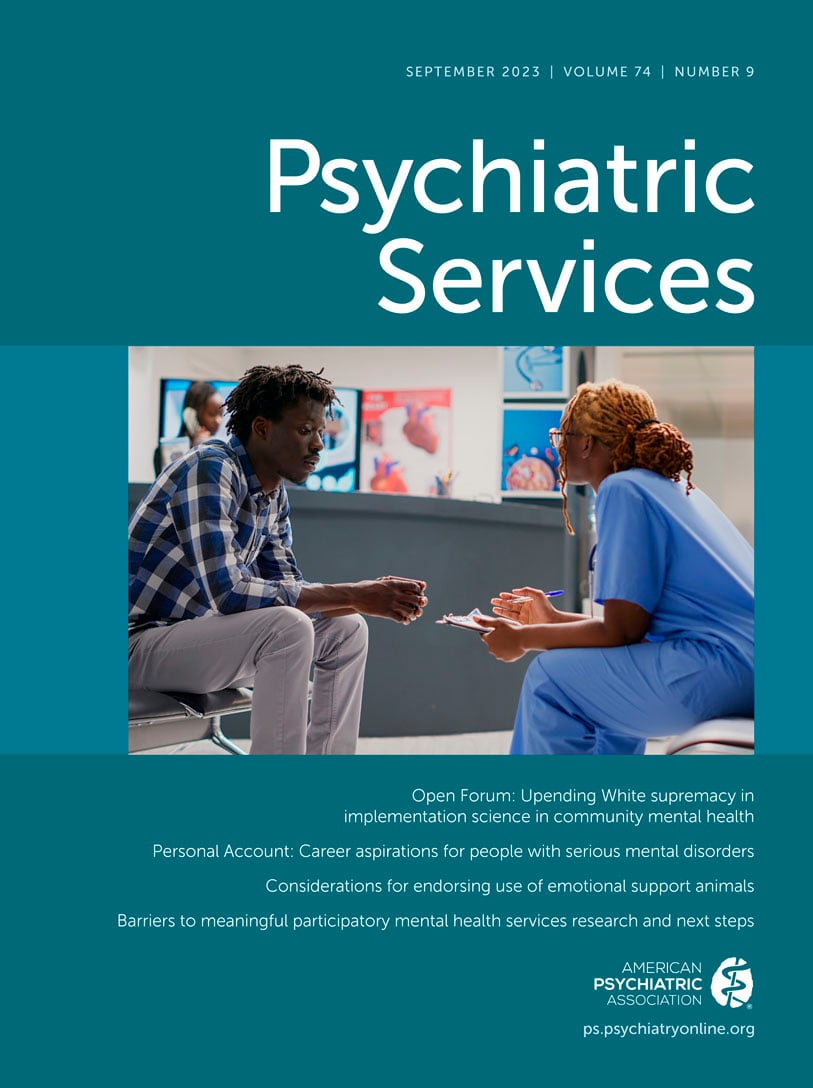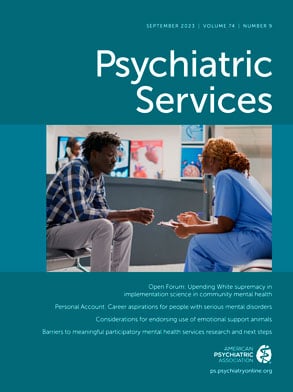Impact of Treatment Initiation and Engagement on Deliberate Self-Harm Among Individuals With First-Episode Psychosis
Abstract
Objective:
Methods:
Results:
Conclusions:
HIGHLIGHTS
Methods
Study Design and Sample
Measures
Statistical Methods
Results
Sample Characteristics
| Characteristic | N | % |
|---|---|---|
| Age at index diagnosis (years) | ||
| 15–19 | 2,990 | 47.1 |
| 20–24 | 3,359 | 52.9 |
| Gender | ||
| Male | 3,200 | 50.4 |
| Female | 3,149 | 49.6 |
| Race-ethnicity | ||
| Non-Hispanic White | 2,891 | 45.5 |
| Non-Hispanic Black | 2,658 | 41.9 |
| Hispanic | 178 | 2.8 |
| Othera | 622 | 9.8 |
| Medicaid eligibility status at index diagnosis | ||
| Poverty | 4,997 | 78.7 |
| Disability | 1,170 | 18.4 |
| Foster care | 102 | 1.6 |
| Otherb | 80 | 1.3 |
| Area of residence | ||
| Metropolitan | 5,421 | 85.4 |
| Nonmetropolitan | 928 | 14.6 |
| Comorbid psychiatric conditionc | ||
| Attention-deficit hyperactivity disorder | 85 | 1.3 |
| Anxiety | 222 | 3.5 |
| Substance use disorder | 688 | 10.8 |
| Other psychiatric disorderd | 294 | 4.6 |
| Chronic medical conditionc | ||
| None | 3,730 | 58.8 |
| Noncomplex | 1,876 | 29.6 |
| Complex | 743 | 11.7 |
| History of self-harmc | 264 | 4.2 |
| Index psychosis category | ||
| Affective disorder | 1,949 | 30.7 |
| Schizophrenia spectrum disorder | 4,400 | 69.3 |
| Previous inpatient mental health carec | 262 | 4.1 |
| Previous emergency department mental health carec | 716 | 11.3 |
Factors Associated With Treatment Initiation and Engagement
| Unadjusted analysis | Adjusted analysisa | |||||||
|---|---|---|---|---|---|---|---|---|
| Characteristic | N | % | OR | 95% CI | p | AOR | 95% CI | p |
| Ages 20–24 years at index diagnosis (reference: 15–19) | 2,324 | 52.6 | .96 | .86–1.07 | .450 | .99 | .89–1.11 | .880 |
| Female gender (reference: male) | 2,133 | 48.3 | .84 | .75–.93 | .001 | .79 | .70–.88 | <.001 |
| Race-ethnicity (reference: Non-Hispanic White) | ||||||||
| Non-Hispanic Black | 1,860 | 42.1 | 1.03 | .92–1.16 | .580 | 1.10 | .97–1.24 | .140 |
| Hispanic | 119 | 2.7 | .89 | .65–1.24 | .500 | .88 | .64–1.22 | .430 |
| Otherb | 437 | 9.9 | 1.05 | .87–1.27 | .630 | 1.07 | .88–1.30 | .490 |
| Medicaid eligibility status at index diagnosis (reference: poverty) | ||||||||
| Disability | 794 | 18.0 | .90 | .79–1.03 | .130 | .94 | .81–1.08 | .390 |
| Foster care | 66 | 1.5 | .78 | .52–1.19 | .240 | .74 | .49–1.13 | .150 |
| Otherc | 56 | 1.3 | 1.00 | .62–1.64 | .980 | 1.05 | .65–1.74 | .860 |
| Nonmetropolitan area of residence (reference: metropolitan) | 660 | 14.9 | 1.09 | .94–1.27 | .280 | 1.11 | .94–1.31 | .230 |
| Comorbid psychiatric conditiond | ||||||||
| Attention-deficit hyperactivity disorder | 64 | 1.5 | 1.34 | .83–2.24 | .250 | 1.52 | .92–2.60 | .110 |
| Anxiety | 141 | 3.2 | .75 | .57–1.00e | .050e | .75 | .55–1.02 | .070 |
| Substance use disorder | 466 | 10.6 | .91 | .77–1.08 | .260 | .90 | .74–1.08 | .250 |
| Other psychiatric disorderf | 194 | 4.4 | .84 | .66–1.08 | .170 | .74 | .53–1.06 | .100 |
| Chronic medical condition (reference: none)d | ||||||||
| Noncomplex | 1,280 | 29.0 | .89 | .79–1.01 | .070 | .91 | .80–1.04 | .170 |
| Complex | 506 | 11.5 | .89 | .75–1.06 | .180 | .95 | .79–1.13 | .560 |
| History of self-harm (reference: no history)d | 191 | 4.3 | 1.15 | .88–1.52 | .320 | 1.12 | .85–1.49 | .430 |
| Schizophrenia spectrum disorder at index date (reference: affective disorder) | 2,945 | 66.6 | .65 | .58–.74 | <.001 | .62 | .54–.70 | <.001 |
| Previous inpatient mental health care (reference: no such previous care)d | 179 | 4.1 | .94 | .72–1.23 | .650 | 1.06 | .73–1.55 | .770 |
| Previous emergency department mental health care (reference: no such previous care)d | 541 | 12.2 | 1.40 | 1.17–1.68 | <.001 | 1.52 | 1.26–1.85 | <.001 |
| Unadjusted analysis | Adjusted analysisa | |||||||
|---|---|---|---|---|---|---|---|---|
| Characteristic | N | % | OR | 95% CI | p | AOR | 95% CI | p |
| Ages 20–24 years at index diagnosis (reference: 15–19) | 1,194 | 49.1 | .73 | .65–.83 | <.001 | .77 | .68–.87 | <.001 |
| Female gender (reference: male) | 1,211 | 49.8 | 1.15 | 1.02–1.29 | .020 | 1.06 | .93–1.20 | .390 |
| Race-ethnicity (reference: Non-Hispanic White) | ||||||||
| Non-Hispanic Black | 949 | 39.0 | .76 | .67–.86 | <.001 | .84 | .73–.97 | .020 |
| Hispanic | 71 | 2.9 | 1.08 | .74–1.58 | .700 | 1.13 | .77–1.66 | .540 |
| Otherb | 252 | 10.4 | .99 | .80–1.22 | .940 | 1.07 | .86–1.33 | .550 |
| Medicaid eligibility status at index diagnosis (reference: poverty) | ||||||||
| Disability | 384 | 15.8 | .72 | .62–.84 | <.001 | .81 | .69–.96 | .010 |
| Foster care | 38 | 1.6 | 1.05 | .64–1.73 | .860 | 1.02 | .62–1.69 | .950 |
| Otherc | 31 | 1.3 | .96 | .56–1.64 | .870 | 1.12 | .65–1.93 | .690 |
| Nonmetropolitan area of residence (reference: metropolitan) | 412 | 17.0 | 1.43 | 1.21–1.70 | <.001 | 1.32 | 1.10–1.59 | .003 |
| Comorbid psychiatric conditiond | ||||||||
| Attention-deficit hyperactivity disorder | 29 | 1.2 | .67 | .41–1.10 | .120 | .69 | .41–1.18 | .180 |
| Anxiety | 73 | 3.0 | .87 | .62–1.22 | .430 | .94 | .65–1.36 | .740 |
| Substance use disorder | 213 | 8.8 | .66 | .54–.80 | <.001 | .63 | .50–.78 | <.001 |
| Other psychiatric disordere | 105 | 4.3 | .96 | .72–1.29 | .800 | 1.02 | .68–1.52 | .920 |
| Chronic medical condition (reference: none)d | ||||||||
| Noncomplex | 712 | 29.3 | 1.02 | .89–1.17 | .780 | 1.01 | .88–1.17 | .880 |
| Complex | 267 | 11.0 | .91 | .75–1.10 | .330 | .96 | .78–1.17 | .660 |
| History of self-harm (reference: no history)d | 99 | 4.1 | .87 | .65–1.17 | .370 | .74 | .55–1.00 | .050 |
| Schizophrenia spectrum disorder at index date (reference: affective disorder) | 1,523 | 62.7 | .67 | .59–.76 | <.001 | .70 | .62–.81 | <.001 |
| Previous inpatient mental health care (reference: no such previous care)d | 101 | 4.2 | 1.06 | .79–1.44 | .700 | 1.36 | .89–2.07 | .150 |
| Previous emergency department mental health care (reference: no such previous care)d | 295 | 12.1 | .98 | .82–1.17 | .810 | 1.01 | .83–1.23 | .900 |
Association of Initiation and Engagement With DSH
| Unweighted | Weighted ATEa | Weighted ATTb | |||||||
|---|---|---|---|---|---|---|---|---|---|
| Treatment | HR | 95% CI | p | HR | 95% CI | p | HR | 95% CI | p |
| Initiation | .63 | .48–.81 | <.001 | .62 | .47–.81 | <.001 | .64 | .52–.80 | <.001 |
| Engagementc | 1.20 | .82–1.78 | .350 | 1.03 | .70–1.50 | .900 | 1.01 | .71–1.43 | .960 |
Discussion
Conclusions
Supplementary Material
- View/Download
- 132.45 KB
References
Information & Authors
Information
Published In
History
Keywords
Authors
Competing Interests
Funding Information
Metrics & Citations
Metrics
Citations
Export Citations
If you have the appropriate software installed, you can download article citation data to the citation manager of your choice. Simply select your manager software from the list below and click Download.
For more information or tips please see 'Downloading to a citation manager' in the Help menu.
View Options
View options
PDF/EPUB
View PDF/EPUBLogin options
Already a subscriber? Access your subscription through your login credentials or your institution for full access to this article.
Personal login Institutional Login Open Athens loginNot a subscriber?
PsychiatryOnline subscription options offer access to the DSM-5-TR® library, books, journals, CME, and patient resources. This all-in-one virtual library provides psychiatrists and mental health professionals with key resources for diagnosis, treatment, research, and professional development.
Need more help? PsychiatryOnline Customer Service may be reached by emailing [email protected] or by calling 800-368-5777 (in the U.S.) or 703-907-7322 (outside the U.S.).

